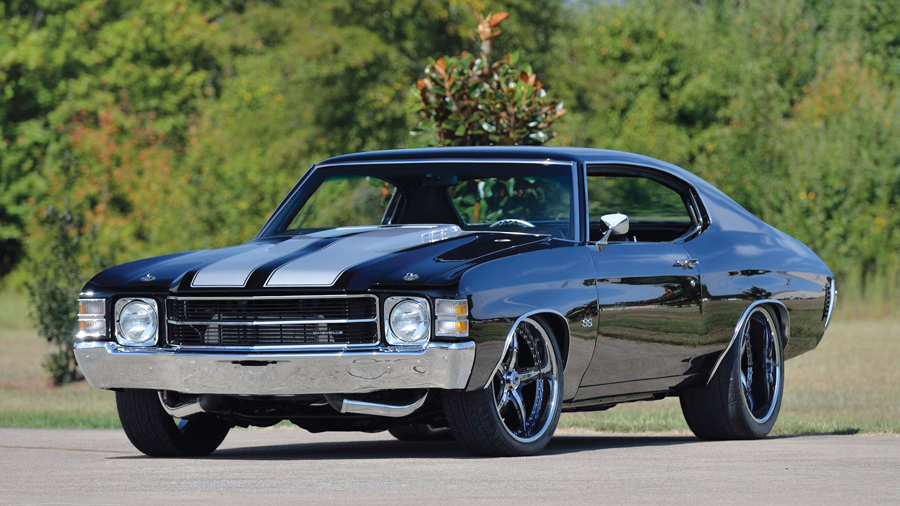- Frame-off rotisserie restoration
- Procharged 496-ci 800-hp Dart engine
- Six-speed manual transmission
- Brembo brakes
- Air conditioning
- Estimated over $200,000 invested in restoration
SCM Analysis
Detailing
| Vehicle: | 1971 Chevrolet Chevelle |
| Years Produced: | 1968–72 |
| Number Produced: | 35,600 base Chevelles (412,889 all models, 1971) |
| Original List Price: | $3,611 |
| SCM Valuation: | $20,500 |
| Tune Up Cost: | $200 |
| Chassis Number Location: | Tag on dash at driver’s A-pillar |
| Engine Number Location: | Pad front in front passenger’s side below cylinder head |
| Alternatives: | 1971 Chevrolet Monte Carlo, 1971 Chevrolet Camaro, 1971 Dodge Charger |
| Investment Grade: | C |
This car, Lot T169, sold for $82,500, including buyer’s premium, at Mecum’s auction in Kissimmee, FL, on January 2–12, 2020.
Mini makeover
1971 saw a mild redesign for the popular Chevelle. The previous year, its sheet metal was squared up, and while the overall body stayed the same for ’71, it did get a mini makeover to stand out from the previous year’s models.
Dual headlights became a single “Power-Beam” flanked by cornering lights, and the square rear taillights were redesigned as double rounds, integrated into the bumper.
It looks the business, but we must pity the muscle-car manufacturers in 1971. There were mileage concerns, insurance concerns, safety-bumper concerns, lower octanes and lower horsepower ratings all starting to affect design. Luckily for the buyer of a 1971 Chevelle in the year 2020, none of that matters, because you can make any trim level into the performance car of your dreams.
That’s basically what was done here.
SS who?
Despite the Super Sport-style black-out paint job, there’s no double S in the middle of the grille of this Chevelle, nor does it sport a jaunty Bowtie, but don’t let that fool you into thinking it’s just a plain old base model.
Somebody took this car apart inside and out, and what they built would leave even a 1970 SS 454 LS6 in the dust and turn a mean corner at the end of the straightaway.
These days, hot-rodding has moved from the straight-line brawlers of Pro-Street to road-race-inspired Pro-Touring builds, where handling and modern street comforts are integrated with old-school muscle car looks and power.
This Chevelle build is a mild Pro-Touring setup. It’s still carbureted, it’s not swapped to a modern LS engine, and it doesn’t have any radical frame or suspension work listed. What it does have is an engine bay full of horses, and an interior that looks perfect for daily driving or long road trips.
Pop the cowl-induction hood and shield your eyes from the reflections off an 800-hp Procharger supercharged and intercooled 496-ci Dart big block. The engine bay is dressed up with billet hood hinges and glistening chrome.
To make sure that the sparkle also has spark, the ignition system has been upgraded to an MSD 6AL. Behind the big block is a 6-speed manual transmission, so your left foot can join in the driving fun.
Announce your arrival through dual turn-down exhaust, and when you’re done painting your name in Nitto 555 tire rubber all over your neighborhood, you can slow it down with four-wheel Brembo disc brakes behind 20-inch Asanti five-spoke wheels.
Classic black
There’s a reason Chevrolet advertised the Chevelle as “America’s Most Popular Mid-Size Car.” Especially after the body changes in 1968, the Chevelle has been a perfect mix of intimidating bulk and sporty promise.
In black, with silver Rally stripes down the deck lid and hood, this Chevelle looks menacing and classy. Its black-and-silver color scheme and modern muscle mash-up continue inside, with bucket seats, 6-speed floor-mounted shifter, white-face gauges, a Billet Specialties steering wheel, air conditioning and a digital stereo system.
Much like how home-buyers can be turned on or off by an easily changed detail like the color of the living room, sellers of customized cars are betting on a shopper with similar taste.
Changing the paint color on a car isn’t as easy as repainting the den, but things like wheels and engine dress-up items can be swapped out in a day, and because the brakes on this car don’t appear to be family-pizza size, a new owner could go down several sizes if he or she preferred a more traditional muscle-car stance.
Usable power
The hard work has been done here. The supercharger and intercooler routing, the new exhaust, the paint, body and interior all look good, and the finished complete product appears to be a solid car that would stand out at a show while still being a comfortable cruiser to take the family to dinner that evening. A/C and that dual-overdrive transmission are big reasons for that. On paper, at least, this car offers the best of both worlds: performance and usability.
So was this a deal? Well, if you’re looking to build something along these lines, sure. Buying someone else’s completed project is almost always cheaper than re-creating it from scratch, even if you end up changing a detail here or there after purchase. The only downside is not knowing every last detail of the build, from the engine through the bodywork. To some, the peace of mind of knowing a car was built “right” is worth the cost of doing that work, even if it’s more expensive than this.
This build seems nicely done, but lacks some commitment to fully embracing Pro-Touring technology with more-modern suspension and fuel injection. Aside from the beefy V8, it looks a little more extreme than it is, and that may have hurt it with buyers who were looking for a contemporary car in old-school sheet metal.
Chevelles of this year, even SS 454 LS5 packages, have an average value of less than $50,000, so even though this car went for below its estimate of $95,000 to $110,000, I’d still say it was fairly well sold.
(Introductory description courtesy of Mecum Auctions.)
